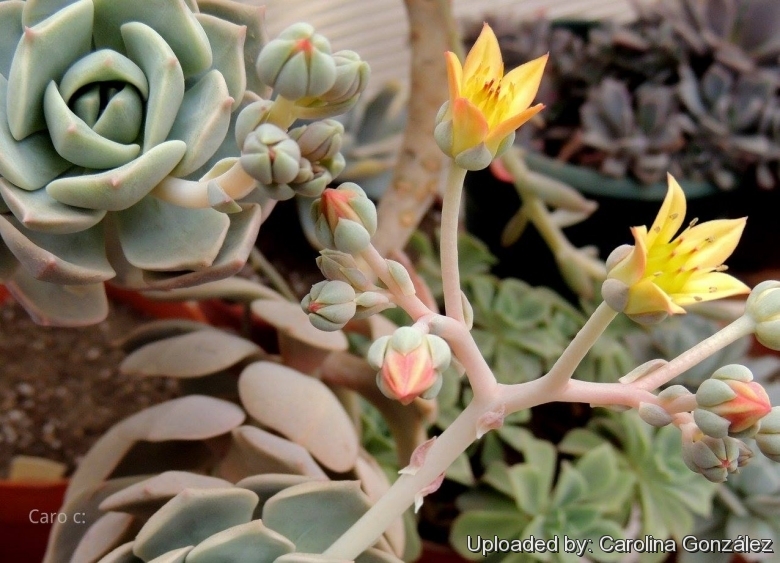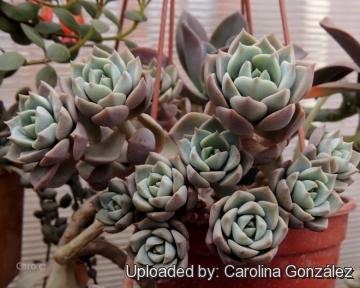
х Graptoveria cv. Titubans Photo by: Carolina González
Origin and Habitat: Graptoveria 'Titubans' is an intergeneric cross between a Graptopetalum paraguayenseSN|27644]]SN|27644]] and an Echevería derenbergii obtained in the United States.
Synonyms:
Common Names include:
ENGLISH: Porcelain Plant
RUSSIAN (Русский): Граптоверия Титубанс
SPANISH (Español): Planta de porcelana.
Description: Graptoveria 'Titubans' is an intergeneric cross between a Graptopetalum paraguayenseSN|27644]]SN|27644]] and an Echevería derenbergii. It has grey-blue leaves that form compact rosettes on creeping stems. It offsets freely producing soon dense carpets or cushions. Grows to about 20 cm tall.
Rosettes: 5-7 cm across, the light blue green, waxy colour is remarkable. In cooler temperature the leaves develop pink or apricot colored tips.
Leaves: Thick, fleshy, spoon-shaped.
Flowers: Produces a yellow flowers in spring.
 х Graptoveria cv. Titubans Photo by: Carolina González
х Graptoveria cv. Titubans Photo by: Carolina González х Graptoveria cv. Titubans Photo by: Carolina González
х Graptoveria cv. Titubans Photo by: Carolina González х Graptoveria cv. Titubans Photo by: Carolina González
х Graptoveria cv. Titubans Photo by: Carolina González х Graptoveria cv. Titubans Photo by: Carolina González
х Graptoveria cv. Titubans Photo by: Carolina GonzálezCultivation and Propagation: Graptoveria cv. TitubansSN|31161]]SN|31161]]' is a delicate hybrid succulent suitable for pots or rock gardens. It is a very easy and reliable plant that can stay outdoors in summer, in mild climate it can grows in the garden where it takes lots of water without rotting.
Exposure: Full sun to partial shade. It prefers a bit of afternoon shade but does also well in bright light with high heat situations. It is however adaptable to low light situations too.
Soil: Plant in fertile free draining soil or a cacti well-drained mix.
Watering: Requires well-drained soil, and only moderate watering. The soil should be allowed to dry between watering, rather than kept perpetually damp.Water well during the warmer months, preferably from below, and sparingly in winter.
Hardiness: It is a hardy hybrid tolerant of a wide range of conditions including some frost. Maintenance: Very low-maintenance plant in suitable growing conditions. Keep in well-draining soil, and protect from frosty conditions.
Uses: Beautiful succulent for container planting adding colour to mixed collections. Excellent for windowsills or as colour accent in rock garden or dish garden. It is a popular groundcover plant in rockeries and water-wise gardens. Ideal for adding dramatic foliage contrast to garden beds and borders and colour to the winter garden.
Propagation: It is usually propagated by suckers or basal leaves, if the plant is repotted some of the bottom leaves can be removed, in order to attempt leaf propagation, it is also a common practice to collect the leaves on the flower stem. However many such cuttings will dry out without producing a plantlet, but with perseverance it is likely to get a few new plants.















